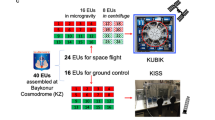Abstract.
Astronauts predictably experience anemia after return from space. Upon entering microgravity, the blood volume in the extremities pools centrally and plasma volume decreases, causing plethora and erythropoietin suppression. There ensues neocytolysis, selective hemolysis of the youngest circulating red cells, allowing rapid adaptation to the space environment but becoming maladaptive on re-entry to a gravitational field. The existence of this physiologic control process was confirmed in polycythemic high-altitude dwellers transported to sea level. Pathologic neocytolysis contributes to the anemia of renal failure. Understanding the process has implications for optimizing erythropoietin-dosing schedules and the therapy of other human disorders. Human and rodent models of neocytolysis are being created to help find out how interactions between endothelial cells, reticuloendothelial phagocytes and young erythrocytes are altered, and to shed light on the expression of surface adhesion molecules underlying this process. Thus, unraveling a problem for space travelers has uncovered a physiologic process controlling the red cell mass that can be applied to human disorders on Earth.
Similar content being viewed by others
Author information
Authors and Affiliations
Corresponding author
Additional information
Electronic Publication
Rights and permissions
About this article
Cite this article
Rice, L., Alfrey, C. Modulation of red cell mass by neocytolysis in space and on Earth. Pflügers Arch - Eur J Physiol 441 (Suppl 1), R91–R94 (2000). https://doi.org/10.1007/s004240000333
Published:
Issue Date:
DOI: https://doi.org/10.1007/s004240000333




